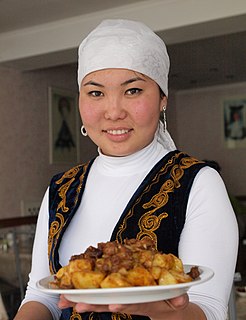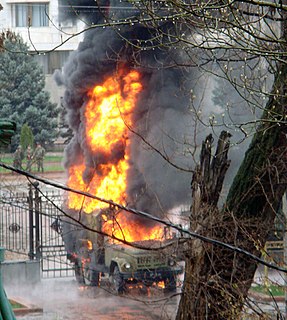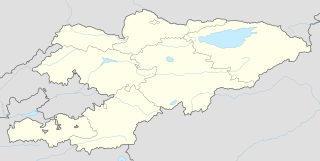
The history of the Kyrgyz people and the land now called Kyrgyzstan goes back more than 2,000 years. Although geographically isolated by its mountainous location, it had an important role as part of the historical Silk Road trade route. In between periods of self-government it was ruled by Göktürks, the Uyghur Empire, and the Khitan people, before being conquered by the Mongols in the 13th century; subsequently it regained independence but was invaded by Kalmyks, Manchus and Uzbeks. In 1876 it became part of the Russian Empire, remaining in the USSR as the Kirghiz Soviet Socialist Republic after the Russian Revolution. Following Mikhael Gorbachev's democratic reforms in the USSR, in 1990 pro-independence candidate Askar Akayev was elected president of the SSR. On 31 August 1991, Kyrgyzstan declared independence from Moscow, and a democratic government was subsequently established.

The Demographics of Kyrgyzstan is about the demographic features of the population of Kyrgyzstan, including population growth, population density, ethnicity, education level, health, economic status, religious affiliations, and other aspects of the population. The name Kyrgyz, both for the people and the country, means "forty girls" or "forty tribes", a reference to the epic hero Manas who unified forty tribes against the Oirats, as symbolized by the 40-ray sun on the flag of Kyrgyzstan.

The Armed Forces of the Kyrgyz Republic, originally formed from former Soviet forces of the Turkestan Military District stationed in newly independent Kyrgyzstan, includes the Army, the Air Force, Air Defence Forces, the Northern and Southern Groups of Forces, Interior Troops, Agency of National Security and Border Troops.

Kyrgyzstan favors close relations with other members of the Commonwealth of Independent States, particularly Kazakhstan and Russia.

Kyrgyz is a Turkic language spoken by about four million people in Kyrgyzstan as well as China, Afghanistan, Kazakhstan, Tajikistan, Turkey, Uzbekistan, Pakistan and Russia. Kyrgyz is a member of the Kyrgyz–Kipchak subgroup of the Kypchak languages, and modern-day language convergence has resulted in an increasing degree of mutual intelligibility between Kyrgyz and Kazakh.
The Kyrgyz Republic national football team is the national team of Kyrgyzstan and is controlled by the Football Federation of the Kyrgyz Republic. It is a member of the Central Asian Football Association, which is a member of the Asian Football Confederation.

Osh is the second largest city in Kyrgyzstan, located in the Fergana Valley in the south of the country and often referred to as the "capital of the south". It is the oldest city in the country, and has served as the administrative center of Osh Region since 1939. The city has an ethnically mixed population of about 281,900 in 2017, comprising Uzbeks, Kyrgyz, Russians, Tajiks, and other smaller ethnic groups. It is about 5 km from the Uzbekistan border.

The "National Anthem of the Kyrgyz Republic" is the title of the current national anthem of Kyrgyzstan, adopted on 18 December 1992 by a resolution of the Supreme Council of Kyrgyzstan. The music was composed by Nasır Davlesov and Qalıy Moldobasanov, and the words were written by Jamil Sadıqov and Eşmambet Quluyev.

Kurmanbek Saliyevich Bakiyev is a politician who served as the second President of Kyrgyzstan, from 2005 to 2010. Large opposition protests in April 2010 led to the takeover of government offices, forcing Bakiyev to flee the country.

Naryn Region is the largest region (oblast) of Kyrgyzstan. It is located in the east of the country and borders with Chuy Region in the north, Issyk Kul Region in the northeast, Xinjiang Uyghur Autonomous Region of China in the southeast, Osh Region in the southwest, and Jalal-Abad Region in the west. Its capital is Naryn. The region was established on 21 November 1939 as Tien-Shan Region. On 20 December 1962 the region was dissolved, but on 11 December 1970 re-established again. On 5 October 1988 it was unified with Issyk-Kul Region, and, finally, on 14 December 1990 it got back its present name: Naryn Region.

Talas Region is a region (oblast) of Kyrgyzstan. Its capital is Talas. It is bordered on the west and north by Jambyl Region of Kazakhstan, on the east by Chuy Region, on the south by Jalal-Abad Region and on the southwest by a finger of Uzbekistan. It is basically a U-shaped valley open to the west. The northern border is defined by the Kyrgyz Ala-Too, which also form the southern border of Chuy Region. At the eastern end, the Talas Ala-Too Range splits off and marks the southern border. The Talas River flows through the center of the valley. The main highway (A361) enters from the east over the Ötmök Pass and goes down the valley to Taraz in Kazakhstan. Near the mouth of the valley at Kyzyl-Adyr, one road goes north toward Taraz and the other south over the Kara-Buura Pass to Jalal-Abad Province. Before independence most trade links were with Taraz. The historic Battle of Talas occurred here.
The culture of Kyrgyzstan has a wide mix of ethnic groups and cultures, with the Kyrgyz being the majority group. It is generally considered that there are 40 Kyrgyz clans, symbolized by the 40-rayed yellow sun in the center of the flag. The lines inside the sun are said to represent a yurt. The dominant religion of Kyrgyzstan is Sunni Islam (91%). The Russian population is Russian Orthodox.

The Supreme Council is the unicameral Parliament of the Kyrgyz Republic. It has 120 seats with members elected for a five-year term by party-list proportional voting.

Almazbek Sharshenovich Atambayev is a Kyrgyz politician who served as the President of Kyrgyzstan from 1 December 2011 to 24 November 2017. He was Prime Minister of Kyrgyzstan from 17 December 2010 to 1 December 2011, and from 29 March 2007 to 28 November 2007. He served as Chairman of the Social Democratic Party of Kyrgyzstan (SDPK) from 30 July 1999 to 23 September 2011.

Kyrgyz cuisine is the cuisine of the Kyrgyz, who comprise a majority of the population of Kyrgyzstan. The cuisine is similar in many aspects to that of their neighbors, particularly Kazakh cuisine.

The Kyrgyz Revolution of 2010, also known as the Second Kyrgyz Revolution, the April Events or officially as the People's April Revolution, began in April 2010 with the ousting of Kyrgyz president Kurmanbek Bakiyev in the capital Bishkek. It was followed by increased ethnic tension involving Kyrgyz people and Uzbeks in the south of the country, which escalated in June 2010. The violence ultimately led to the consolidation of a new parliamentary system in Kyrgyzstan.
The 2010 South Kyrgyzstan riots were clashes between ethnic Kyrgyz and Uzbeks in southern Kyrgyzstan, primarily in the cities of Osh and Jalal-Abad, in the aftermath of the ouster of former President Kurmanbek Bakiyev on 7 April. It is part of the larger Kyrgyz Revolution of 2010. Violence that started between Kyrgyz and Uzbeks on 19 May in Jalal-Abad escalated on 10 June in Osh.

Kanysh-Kiya Airport is an airport outside Kanysh-Kiya, a village in Chatkal District of Jalal-Abad Province (oblast) of Kyrgyzstan. The Russian IATA code for Kanysh-Kiya Airport is КШЯ.

Sooronbay Sharipovich Jeenbekov is a Kyrgyz politician, and the President of Kyrgyzstan. He officially took office on 24 November 2017. He was also the Prime Minister of Kyrgyzstan from April 2016 to August 2017.

















